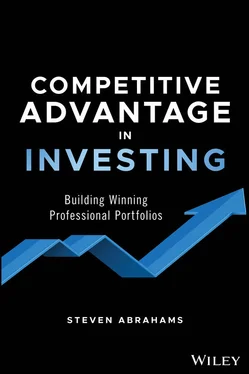In the real world, companies do not flip coins to earn returns but they do take risks. Companies can take the same or different risks, those risks can overlap partially or wholly, and the sensitivity to those risks can vary as well. Some companies buy bricks and mortar and lumber, for instance, and turn them into buildings. Some companies own airplanes, trains, trucks, or automobiles and move materials around to different buyers. Some companies buy and sell buildings. Some companies take computer chips and software and make computers. Some companies buy meats and vegetables and make restaurant meals. Some companies do nearly the same thing but in different places. This list of things that companies do is as endless as is the list of companies itself. Sometimes the risks provide good return; sometimes they do not, just like a coin can come up heads or tails.
This idea of flipping coins and taking risks extends beyond companies to all investments. The value of the cash in the drawer depends on inflation, so the owner with the key to the drawer has flipped an inflation coin. The value of a loan or bond depends on interest rates, so those investments flip the interest rate coin. The value of an oil company depends on the supply-and-demand-for-oil coins.
Once it becomes clear that companies or investments flip different risk coins, then building a diversified portfolio becomes a hunt in part for investments that flip different coins and take different risks. Some risks are truly independent, but some are related. Companies in very different businesses, very different locations, or both may show returns that look relatively independent. Companies in the same or similar business may show returns that look related or correlated.
In practice, companies and investments usually take multiple dimensions of risk. And each investment's performance may show different sensitivity to each dimension of risk. 6 Items on a menu of investments could show sensitivity to interest rates or corporate profits or the weather or new technologies, and a given investment may be more sensitive to one risk than to another.
Instead of thinking of a menu of investments as a list of instruments or companies or funds, it is better to think of the risk dimensions packed into a given investment—the list of risk coins being flipped or the risks embedded in each item on the menu. Some investments involve the same or similar risks; other investments involve very different risks. Some involve concentrated risks; others involve a broad set of risks. Some risks actually offset others. By looking through the individual items on the infinite list of investments to the underlying risk dimensions, the actual number of choices that an investor has to make goes down dramatically. Even a few risk dimensions can be combined in different amounts to create an infinite list of investments. But the underlying risk dimensions are much smaller, and the investor's challenge much more manageable.
Because each item on the investment menu involves a different set of risks and different sensitivity to each risk, an investor can shape the return, risk, and correlation among elements of a portfolio by combining different items from the menu. The investor can choose which risks to take and which risks to avoid. And as different dimensions of risk come in and out of a portfolio, then performance of the portfolio changes. Rather than choosing from a menu with an infinite set of discrete investments, an investor builds a portfolio from an underlying set of broader risks.
Markowitz's Open Questions
Markowitz also left open an essential aspect of his approach: the best way to determine expected return, risk, and diversification:
To use the E-V ( expected return and variance ) rule in the selection of securities we must have procedures for finding reasonable (expected returns and variances). These procedures, I believe, should combine statistical techniques and the judgment of practical men. My feeling is that the statistical computations should be used to arrive at a tentative set of (returns and variances). Judgment should then be used in increasing or decreasing some of these (returns and variances) on the basis of factors or nuances not taken into account by the formal computations. (Markowitz, 1952, p. 91)
Despite the investors' essential job of combining risk, return, and correlation into portfolio performance, Markowitz still left open the best way to predict these things. If use of time is a good signal, then performance depends on expectations about asset cash flow and plausible changes in the relevant risk factors. A large block of investors' time goes to anticipating asset cash flow, whether it is earnings or dividends in the case of equity securities or coupons, option exercise, prepayments, or defaults in the case of fixed income securities. Another block goes to anticipating the path of events that might re-price securities such as changes in monetary or fiscal policy, politics, the economy, interest rates or option prices, science or technology, or other factors. These effectively are the risk exposures embedded in available securities. The intersection between probable scenarios and the value of specific security cash flows is the daily work of portfolio construction.
In a Markowitz world, investors may end up with competitive advantage. Some investors may simply have more or different or better information than others. Some may be able to run faster or better analysis. Some investors may be able to consistently anticipate the return, risk, and correlation of assets more accurately than others. Some may be able to consistently build portfolios that perform better than others'. Markowitz would expect a return to investing in research and analysis.
But most individuals or organizations will lack the resources to develop comparative advantage along every underlying risk factor. When an investor has no clear advantage or disadvantage, diversification improves returns to risk-taking by washing out idiosyncratic risk. Diversification protects an investor from his or her own blind spots.
Arguably the greatest value in Markowitz's framework is to emphasize the importance of trading off risk and return. Each investor operates in a multidimensional return-risk space and constantly faces choices not just about the best combination of securities to hold but also the combination of risk dimensions along which to optimize. If investors can identify their universe of securities and the underlying risk dimensions, Markowitz provided a starting road map for making those choices. Each investment ultimately reduces to risk, return, and correlation. That reduces the infinite menu of investments to a smaller and more manageable set.
What Markowitz did not do, however, is provide a specific recommendation about how to build a portfolio. He led us to the efficient frontier but does not tell us where to settle. For that, the world had to wait for William Sharpe and the capital asset pricing model (1969 Sharpe, 1964; Lintner, 1965).
1 1The value of cash flow over time depends on the cost to borrow money. That is the definition of a rate of interest. Various individuals and companies compete to borrow money over different horizons: a day, a week, a month, a year, 5 or 10 years and so on. Investors with disposable cash lend to borrowers. The demand for and supply of money at each horizon sets a price often called the real rate of interest. An investor may lend at the real rate of interest but still need compensation for inflation and other risks. The real rate, along with compensation for other risks, sets the nominal interest rate. That nominal rate becomes part of a present value calculation. Imagine a company that pays a $1 dividend each year. Over 10 years, the company would pay $10. If the real rate of interest over 10 years is 2.5% and the investor's cost of living goes up 2.5% a year, then the stream of dividends is worth only $7.72 today: . If the investor worries that the company could go out of business and needs something extra to compensate, say another 2.5% a year, then the stream of dividends is worth only $6.84 today:
Читать дальше












